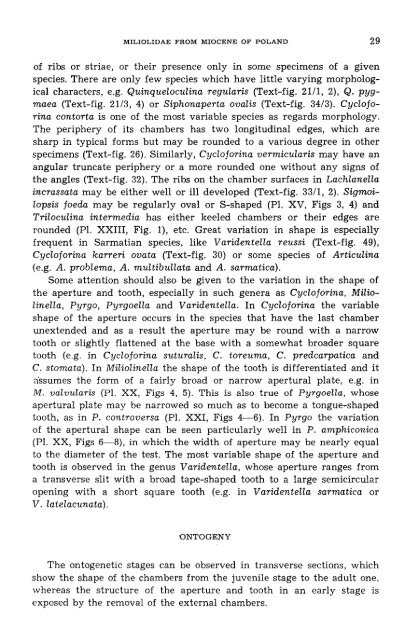MILIOLIDAE - Acta Palaeontologica Polonica
MILIOLIDAE - Acta Palaeontologica Polonica
MILIOLIDAE - Acta Palaeontologica Polonica
Create successful ePaper yourself
Turn your PDF publications into a flip-book with our unique Google optimized e-Paper software.
<strong>MILIOLIDAE</strong> FROM MIOCENE OF POLAND 29<br />
of ribs or striae, or their presence only in some specimens of a given<br />
species. There are only few species which have little varying morphological<br />
characters, e.g. Quinqueloculina regularis (Text-fig. 21/1, 2), Q. pygmaea<br />
(Text-fig. 21/3, 4) or Siphonaperta ovalis (Text-fig. 34/3). Cycloforina<br />
contorta is one of the most variable species as regards morphology.<br />
The periphery of its chambers has two longitudinal edges, which are<br />
sharp in typical forms but may be rounded to a various degree in other<br />
specimens (Text-fig. 26). Similarly, Cyclojorina vermicularis may have an<br />
angular truncate periphery or a more rounded one without any signs of<br />
the angles (Text-fig. 32). The ribs on the chamber surfaces in Lachlanella<br />
incrassata may be either well or ill developed (Text-fig. 33/1, 2). Sigmoilopsis<br />
foeda may be regularly oval or S-shaped (PI. XV, Figs 3, 4) and<br />
Triloculina intermedia has either keeled chambers or their edges are<br />
rounded (PI. XXIII, Fig. 1), etc. Great variation in shape is especially<br />
frequent in Sarmatian species, like Varidentella reussi (Text-fig. 49),<br />
Cycloforina karreri ovata (Text-fig. 30) or some species of Articulina<br />
(e.g. A. problema, A. multibullata and A. sarmatica).<br />
Some attention should also be given to the variation in the shape of<br />
the aperture and tooth, especially in such genera as Cycloforina, Miliolinella,<br />
Pyrgo, Pyrgoella and Varidentella. In Cycloforina the variable<br />
shape of the aperture occurs in the species that have the last chamber<br />
unextended and as a result the aperture may be round with a narrow<br />
tooth or slightly flattened at the base with a somewhat broader square<br />
tooth (e.g. in Cycloforina suturalis, C. toreuma, C. predcarpatica and<br />
C. stomata). In Miliolinella the shape of the tooth is differentiated and it<br />
assumes the form of a fairly broad or narrow apertural plate, e.g. in<br />
M. valvularis (PI. XX, Figs 4, 5). This is also true of Pyrgoella, whose<br />
apertural plate may be narrowed so much as to become a tongue-shaped<br />
tooth, as in P. controversa (PI. XXI, Figs 4-6). In Pyrgo the variation<br />
of the apertural shape can be seen particularly well in P. amphiconica<br />
(PI. XX, Figs 6-8), in which the width of aperture may be nearly equal<br />
to the diameter of the test. The most variable shape of the aperture and<br />
tooth is observed in the genus Varidentella, whose aperture ranges from<br />
a transverse slit with a broad tape-shaped tooth to a large semicircular<br />
opening with a short square tooth (e.g. in Varidentella sarmatica or<br />
V. latelacunata).<br />
ONTOGENY<br />
The ontogenetic stages can be observed in transverse sections, which<br />
show the shape of the chambers from the juvenile stage to the adult one,<br />
whereas the structure of the aperture and tooth in an early stage is<br />
exposed by the removal of the external chambers.
















